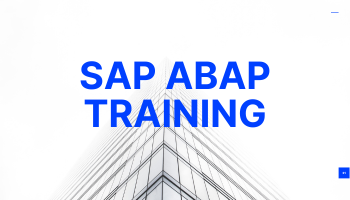Your cart is currently empty.
SAP ABAP Training in Bangalore is one of the many application-specific fourth-generation languages. Duties of an ABAP’er would include developing and maintaining programs to enhance the assigned application module using the SAP Development tools. Collaborate with the SAP Project Management, Business and Systems Analyst and user departments to develop specifications for system enhancements for continuous functional improvement. Develop Test Plans and automated scripts to assure expected performance quality levels meet standards in development efforts. Implement technical architecture surrounding the package.

Online-Classroom
3 Months Duration
Live Class Facilities
Interviews Assured
Live Server
SAP ABAP Training in Bangalore| (Advanced Business Application Programming) is a high-level programming language developed by the German software company SAP SE. ABAP is the primary language used for programming SAP applications, and it plays a crucial role in the customization and development of SAP software solutions. Here are key aspects of SAP ABAP
SAP ABAP Training in Bangalore. A well-designed training program covers a comprehensive curriculum that includes fundamental and advanced concepts of SAP ABAP. This may include topics like data dictionary, ABAP programming constructs, SAP scripting, and more.
Practical exposure is crucial in SAP ABAP training. Look for programs that provide hands-on exercises, real-world scenarios, and access to a live SAP system for practical application of concepts.
Training programs are enhanced when led by experienced instructors who have practical industry experience with SAP ABAP. Instructors should be knowledgeable about current industry practices and SAP technologies.
Engaging with real-life projects and case studies allows participants to apply their knowledge in practical situations, preparing them for actual challenges they might encounter in their careers.
A good training program may include preparation for SAP ABAP certification exams, ensuring that participants are well-equipped to pass the exams and obtain SAP certifications.
Different individuals have different learning preferences. Training programs that offer flexibility in learning options, such as classroom training, online instructor-led sessions, or self-paced e-learning, cater to diverse needs.
Post-training support in the form of additional resources, forums, or consultation can be valuable. This support ensures that participants can clarify doubts or seek guidance after completing the formal training. Career Guidance and Placement Assistance: Some training providers offer career guidance, resume building, interview preparation, and even job placement assistance. This can be beneficial for individuals looking to enter or advance in the SAP job market.
An interactive learning environment, which may include discussions, Q&A sessions, and collaboration with fellow participants, enhances the overall learning experience.
The SAP ecosystem evolves, so training content should be up-to-date with the latest advancements in SAP ABAP and related technologies.
SAP ABAP Training in Bangalore. As an SAP ABAP Developer, The most straightforward path is to work as an SAP ABAP Developer. In this role, professionals are responsible for designing, coding, testing, and implementing SAP solutions using ABAP.
Via SAP Technical Consultant, Technical consultants specializing in SAP often need strong ABAP skills. They work on implementing, customizing, and optimizing SAP solutions to meet the specific needs of clients.
Via SAP Integration Specialist,Professionals with SAP ABAP skills may specialize in integration, working on connecting SAP systems with other enterprise applications, external systems, or cloud platforms.
Via SAP Fiori Developer,With the rise of SAP Fiori as a user experience design approach, ABAP professionals can specialize in developing Fiori apps, enhancing the user interface and overall user experience of SAP applications.
Via SAP S/4HANA Developer,As organizations transition to SAP S/4HANA, there's a demand for developers who can work with the new architecture. ABAP skills are crucial for adapting existing solutions or creating new ones in the S/4HANA environment.
Via SAP Security Consultant,Security is a critical aspect of SAP implementations. ABAP professionals may focus on SAP security, ensuring that the system is protected from unauthorized access and maintaining compliance with security standards.
Via SAP Technical Architect,Technical architects in the SAP domain design and oversee the technical aspects of SAP implementations. ABAP skills are valuable for understanding the technical landscape and ensuring optimal system performance.
Via ABAP Development Team Lead/Manager,With experience, professionals can move into leadership roles where they manage ABAP development teams, coordinate projects, and contribute to overall IT strategy.
Via SAP Upgrade Specialist,As SAP systems evolve, professionals with ABAP skills are needed to manage and execute system upgrades, ensuring a smooth transition to newer SAP versions.
Via Freelance/Consulting,ABAP professionals may choose to work as freelancers or consultants, offering their expertise to multiple clients for specific projects, troubleshooting, or optimization tasks.
Via SAP Trainer,Professionals with strong ABAP knowledge can transition into training roles, educating others on ABAP programming, SAP development best practices, and related topics.
Via Business Intelligence Developer (BW/4HANA),ABAP professionals may extend their skills to work in SAP Business Warehouse (BW) environments or with SAP BW/4HANA, focusing on data modeling, extraction, and reporting.